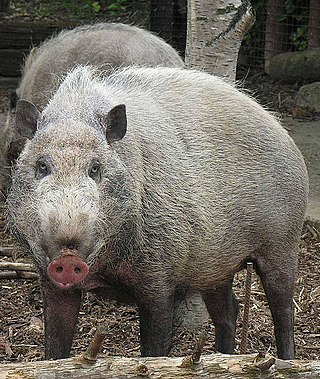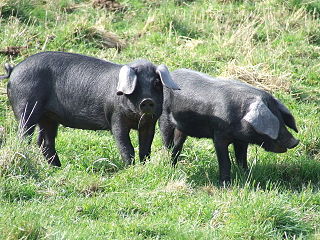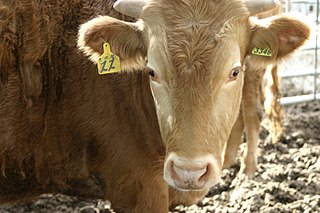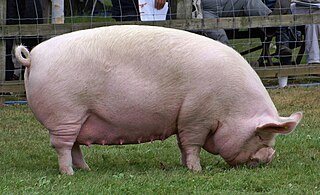Related Research Articles

Sus is the genus of wild and domestic pigs, within the even-toed ungulate family Suidae. Sus include domestic pigs and their ancestor, the common Eurasian wild boar, along with other species. Sus species, like all suids, are native to the Eurasian and African continents, ranging from Europe to the Pacific islands. Suids other than the pig are the babirusa of Indonesia, the pygmy hog of South Asia, the warthogs of Africa, and other pig genera from Africa. The suids are a sister clade to peccaries.

Wagyu is the collective name for the four principal Japanese breeds of beef cattle. All wagyū cattle derive from cross-breeding in the early twentieth century of native Japanese cattle with imported stock, mostly from Europe.

The Japanese Black is a breed of Japanese beef cattle. It is one of six Japanese cattle breeds, and one of the four Japanese breeds known as wagyū, the others being the Japanese Brown, the Japanese Polled and the Japanese Shorthorn. All wagyū cattle derive from cross-breeding in the early twentieth century of native Japanese cattle with imported stock, mostly from Europe. In the case of the Japanese Black, the foreign influence was from European breeds including Braunvieh, Shorthorn, Devon, Simmental, Ayrshire and Holstein.

The Berkshire is a British breed of pig. It originated in the English county of Berkshire, for which it is named. It is normally black, with some white on the snout, on the lower legs, and on the tip of the tail.

The Japanese Brown is a breed of small Japanese beef cattle. It is one of six native Japanese cattle breeds, and one of the four Japanese breeds known as wagyū, the others being the Japanese Black, the Japanese Polled and the Japanese Shorthorn. All wagyū cattle derive from cross-breeding in the early twentieth century of native Japanese cattle with imported stock, mostly from Europe. In the case of the Japanese Brown, the principal foreign influence was from the Korean Hanwoo and Swiss Simmental breeds.
The Ukrainian White Steppe is Ukrainian breed of general-purpose pig. It was developed in the early twentieth century by M.F. Ivanov at the experimental farm of Askania Nova, in Kherson Oblast in southern Ukraine, at that time in the Soviet Union; it was the first Soviet pig breed to be developed. It derived from cross-breeding of pigs native to southern Ukraine with imported Large White boars. It was officially recognised in 1932.

The Large Black pig is a British breed of domestic pig. It is the only British pig that is entirely black. It was created in the last years of the nineteenth century by merging the black pig populations of Devon and Cornwall in the south-west with those of Essex, Suffolk and Kent in the south-east. It is hardy, docile and prolific; it forages well and is suitable for extensive farming, but not well suited to intensive management.

The Mangalica is a Hungarian breed of domestic pig. It was developed in the mid-19th century by crossbreeding breeds from the nearby Romanian Salonta and Hungarian Bakony with the European wild boar and the Serbian Šumadija breed. The Mangalica pig grows a thick, curly coat of hair. The only other pig breed noted for having a long coat is the extinct Lincolnshire Curly Coat pig of England.

The Hanwoo, also Hanu or Korean Native, is a breed of small cattle native to Korea. It was formerly used as a draught animal, but this use has almost disappeared. It is now raised mainly for meat. It is one of four indigenous Korean breeds, the others being the Chikso, the Heugu and the Jeju Black.

The Jezersko–Solčava is a breed of domestic sheep from the eastern Alpine region of Europe. Until the outbreak of the First World War it was the most numerous sheep breed in southern Carinthia, in Friuli and in Slovenia. Its name derives from the regions of Jezersko and of Solčava, formerly in the Austrian Empire, now in Slovenia. It is raised also in parts of Austria, Germany and Italy; a small number were imported to Serbia in 1991. It may also be known as the German: Kärntner Brillenschaf, Seeländer Schaf or Villnösser Schaf, or as the Slovene: jezersko-solčavska ovca.

Miniature Pigs, also called mini pig, or Pygmy pig, or teacup pig, are small breeds of domestic pig. There a two types of mini pig: small traditional pig breed like the Vietnamese Pot-Bellied pig, the Choctaw hog and even smaller newer breeds like Göttingen minipig and Juliana pig.

The Meishan is a breed of domestic pig named for the Meishan, Jiangsu Province, China. It is a sub-group of the Taihu pig and is a small to medium-sized breed with large drooping ears, and wrinkled black skin. Meishan Pigs are extremely docile and renowned for their tender and flavorful red meat pork.
In Sri Lanka many farmers depend on animal husbandry for their livelihood, but not a large proportion. Therefore, many livestock products have to be imported. The main livestock products in Sri Lanka are milk, meat and eggs. Hides, wools and other products are still not produced within the country. Animal power formerly used in the cultivation of rice and vegetables have been replaced by modern technology to farmlands. However animal husbandry plays an important role in the rural economy for improving the living conditions of farmers in the country.

The Middle White is a British breed of domestic pig. It originated in Yorkshire, and derived from the Large White and the now-extinct Small White. It was recognised in 1852, and the first herd-book was published in 1884. It is a porker, reared for fresh pork, and is characterised by a short and sharply-upturned snout. After the Second World War it came close to extinction; although numbers have recovered somewhat, it is listed by the Rare Breeds Survival Trust as "priority" – the highest level of risk.

The Welsh is a breed of domestic pig native to Wales. It is a large white breed known for its hardiness in outdoor (extensive) farming, its long, pear-shaped body and its lop-ears. The breed was first mentioned in the 1870s, and after the Howitt committee report in 1955, became the third most common sire in the United Kingdom after the Large White pig and British Landrace pig. The Welsh pig experienced a decline in numbers in the late twentieth century because consumer demands had changed and the carcase was considered too fatty. In 2005 the breed was considered endangered and later came under the auspices of the Rare Breeds Survival Trust. Since then numbers have expanded somewhat, and by 2012, the registered breeding herd had increased to over 1000 animals.

The Italian Landrace is an Italian breed of domestic pig. It derives from the Danish Landrace breed developed in Denmark at the end of the nineteenth century. Stock was imported into Italy after the Second World War. The breed has been selected principally for suitability for the production of prosciutto crudo. It is, after the Large White Italiana, the second-most numerous pig breed in Italy. The breed standard is issued by the Ministero delle Politiche Agricole Alimentari e Forestali, the Italian ministry of agriculture and forestry; the herdbook is kept by the Associazione Nazionale Allevatori Suini, the national pig-breeders' association.
The Large White Italiana is the Italian strain of the British Large White or Yorkshire breed of pig. It is the most numerous pig breed in Italy. It is one of the seven pig breeds of foreign origin recognised by the Ministero delle Politiche Agricole Alimentari e Forestali, the Italian ministry of agriculture and forestry, and one of the four for which a genealogical herdbook is kept by the Associazione Nazionale Allevatori Suini, the Italian national association of pig-breeders.
The Kagoshima Berkshire, Japanese: かごしま黒豚, is a Japanese breed of domestic pig found in Kagoshima prefecture in south-western Japan. It derives from the Berkshire breed of pig of the United Kingdom, which was imported to Japan from the 1860s and is now widespread there. The Kagoshima Berkshire apparently descends from two British Berkshire pigs brought to Japan in the 1930s. Meat from this breed may be marketed under the brand name "Kurobuta", meaning "black pig". Pork from Kagoshima Berkshire pigs constitutes approximately 2% of the total annual production in Japan. The meat is considered tender and flavoursome; it is a premium product, in demand throughout the country.
References
- 1 2 "Breed data sheet: Korean Native/Korea, Republic of". Domestic Animal Diversity Information System of the Food and Agriculture Organization of the United Nations. Retrieved 18 October 2015.
- ↑ Edea, Z; Kim, S. W.; Lee, K. T.; Kim, T. H.; Kim, K. S. (2014). "Genetic Structure of and Evidence for Admixture between Western and Korean Native Pig Breeds Revealed by Single Nucleotide Polymorphisms". Asian-Australasian Journal of Animal Sciences. 27 (9): 1263–1269. doi:10.5713/ajas.2014.14096. PMC 4150192 . PMID 25178369.
- Porter, V. (1993) Pigs, a handbook to the breeds of the World. Helm information Ltd. UK.